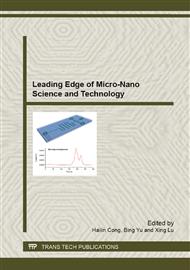[1]
X.F. Lu, W.J. Zhang, C. Wang, C.H. Wen, Y. Wei, One-dimensional conducting polymer nanocomposites: Synthesis, properties and applications, Prog. Polym. Sci. 36 (2011) 671–712.
DOI: 10.1016/j.progpolymsci.2010.07.010
Google Scholar
[2]
X. Li, I. Zhitomirsky, Capacitive behaviour of polypyrrole films prepared on stainless steel substrates by electropolymerization, Mater. Lett. 76 (2012) 15–17.
DOI: 10.1016/j.matlet.2012.02.058
Google Scholar
[3]
D. Li, J.X. Huang, R.B. Kaner, Polyaniline nanofibers: a unique polymer nanostructure for versatile applications, Acc. Chem. Res. 42 (2009) 135–145.
DOI: 10.1021/ar800080n
Google Scholar
[4]
B.J. Kim, S.G. Oh, M.G. Han, S.S. Im, Preparation of polyaniline nanoparticles in micellar solutions as polymerization medium, Langmuir 16 (2000) 5841–5845.
DOI: 10.1021/la9915320
Google Scholar
[5]
P.A. Hassan, S.N. Sawant, N.C. Bagkar, V.J. Yakhmi, Langmuir 20 (2004) 4874–4880.
DOI: 10.1021/la0498096
Google Scholar
[6]
X.G. Li, A. Li, M.R. Huang, Y.Z. Liao, Y.G. Lu, Efficient and scalable synthesis of pure polypyrrole nanoparticles applicable for advanced nanocomposites and carbon nanoparticles, J. Phys. Chem. C 114 (2010) 19244–19255.
DOI: 10.1021/jp107435b
Google Scholar
[7]
X.G. Li, J. Li, M.R. Huang, Facile optimal synthesis of inherently electroconductive polythiophene nanoparticles, Chem. Eur. J. 15 (2009) 6446–6455.
DOI: 10.1002/chem.200900181
Google Scholar
[8]
X.Q. Liu, Y.P. Guan, Z.Y. Ma, H.Z. Li, Surface modification and characterization of magnetic polymer nanospheres prepared by miniemulsion polymerization, Langmuir 20 (2004) 10278–10282.
DOI: 10.1021/la0491908
Google Scholar
[9]
T.J. Yao, T.Y. Cui, J. Wu, Q.Z. Chen, S.W. Lu, K.N. Sun, Preparation of hierarchical porous polypyrrole nanoclusters and their application for removal of Cr(VI) ions in aqueous solution, Polym. Chem. 2 (2011) 2893–2899.
DOI: 10.1039/c1py00311a
Google Scholar
[10]
K.J. Wynne, G.B. Street, Poly(Pyrrol-2-ylium tosylate) - electrochemical synthesis and physical and mechanical-properties, Macromolecules 18 (1985) 2361–2368.
DOI: 10.1021/ma00154a005
Google Scholar
[11]
S. Fujii, A. Aichi, K. Akamatsu, H. Nawafune, Y. Nakamura, One-step synthesis of polypyrrole-coated silver nanocomposite particles and their application as a coloured particulate emulsifier, J. Mater. Chem. 17 (2007) 3777–3779.
DOI: 10.1039/b709413b
Google Scholar


